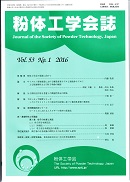All issues

Volume 53, Issue 1
Displaying 1-5 of 5 articles from this issue
- |<
- <
- 1
- >
- >|
Original Paper
-
Daisuke Sakaniwa, Junzhu Wang, Yoshinori Takayama, Mikio Sakai2016 Volume 53 Issue 1 Pages 4-13
Published: January 10, 2016
Released on J-STAGE: January 23, 2016
JOURNAL FREE ACCESSIn order to replicate the particle behavior and to predict the pressure drop and collection efficiency of a cyclone collector, observation of the granulated-sugar particle behavior using transparent cyclone collector and the numerical simulation by discrete element method coupled with computational fluid dynamics (DEM-CFD) were made. Comparing the observed particle behavior and the pressure drop to the results calculated by DEM-CFD analysis, DEM-CFD results are well reproducing those of observed results. Moreover, to compare the DEM-CFD results and the results calculated by general continuum modeling for the multiphase analysis, numerical simulation by Euler-Granular was also performed. Result from Euler-Granular analysis shows that particles spread wider than that of DEM-CFD, in the meantime particles flow adjacent to the inner wall of cyclone at observed and DEM-CFD results. These comparisons indicate that DEM-CFD has an advantage in analysis of cyclone collector.View full abstractDownload PDF (2189K)
Review
-
Yuichi Tozuka2016 Volume 53 Issue 1 Pages 14-20
Published: January 10, 2016
Released on J-STAGE: January 23, 2016
JOURNAL RESTRICTED ACCESSThe particle design with functional properties is an important aspect for the pharmaceutical and food sciences. Poor water solubility of active ingredient and/or food constituent may lead to a crucial absorption problem. To overcome this problem, we investigated the feasibility of recently developed transglycosylated additives, e.g., α-glucosyl hesperidin, α-glucosyl stevia, and α-glucosyl rutin, to improve the dissolution and bioavailability of poorly water-soluble drug and food ingredient. We found that trans-glycosylated materials formed self-associated aggregated-nanostructures in aqueous media, and their structure was different among three. The poorly water soluble drugs could intercorporate the nanostructure, creating nanocomposite structure of hydrophobic drug/transglycosylated additives. The best way to create a functional of hydrophobic compounds/transglycosylated additives was found to be a spray-drying. Spray-dried particles of drug/trans-glycosylated materials showed a significantly higher dissolution rate and greater absorption profile compared with the commercial drug powder.View full abstractDownload PDF (1879K)
Review: Frontier Research Series
-
Noriko Ogawa2016 Volume 53 Issue 1 Pages 21-26
Published: January 10, 2016
Released on J-STAGE: January 23, 2016
JOURNAL RESTRICTED ACCESSSalt forms are frequently used in solid dosage forms because they can improve aqueous solubility and chemical stability relative to the non-ionic form of the active compound. However, absorption of drugs through biological membranes could be improved by enhancing the solubility of the non-ionic form by using cyclodextrins (CDs) because the non-ionic form is more hydrophobic than the ionic form (salts). In this paper, the studies about improvement of water solubility and physicochemical characterization of CD-drug interaction in the solid and solution state were introduced using fentanyl base as a model of poorly water soluble drugs (free base) and CDs.View full abstractDownload PDF (1759K)
Review: Practical Environmental Technology Series
-
Yasuyoshi Sekine2016 Volume 53 Issue 1 Pages 27-32
Published: January 10, 2016
Released on J-STAGE: January 23, 2016
JOURNAL RESTRICTED ACCESSIn this article we will explain how the ratio of the vessel length to the vessel diameter (L/D), the material and shape of the grinding chamber and the bead-size differences, which have important roles in the selection of the bead mill, actually affect the processing capacity and energy efficiency of the production process. Although the use of microbeads has risen in the recent years, it may result in the negative effects not only on the processing capacity and energy efficiency but also on the properties of the final product if the bead mill is being operated with worn beads and alien substances. Therefore, in addition, we will introduce you to the device which can easily sort out worn microbeads.View full abstractDownload PDF (2969K)
Fundamentals of Powder Technology, 2nd Edition
-
1. 3. 5 Determination of Size and Size Distribution of Powder 1. 3. 6 Overview of Particle Size AnalysisYasushige Mori2016 Volume 53 Issue 1 Pages 33-39
Published: January 10, 2016
Released on J-STAGE: February 03, 2017
JOURNAL RESTRICTED ACCESSDownload PDF (1430K)
- |<
- <
- 1
- >
- >|